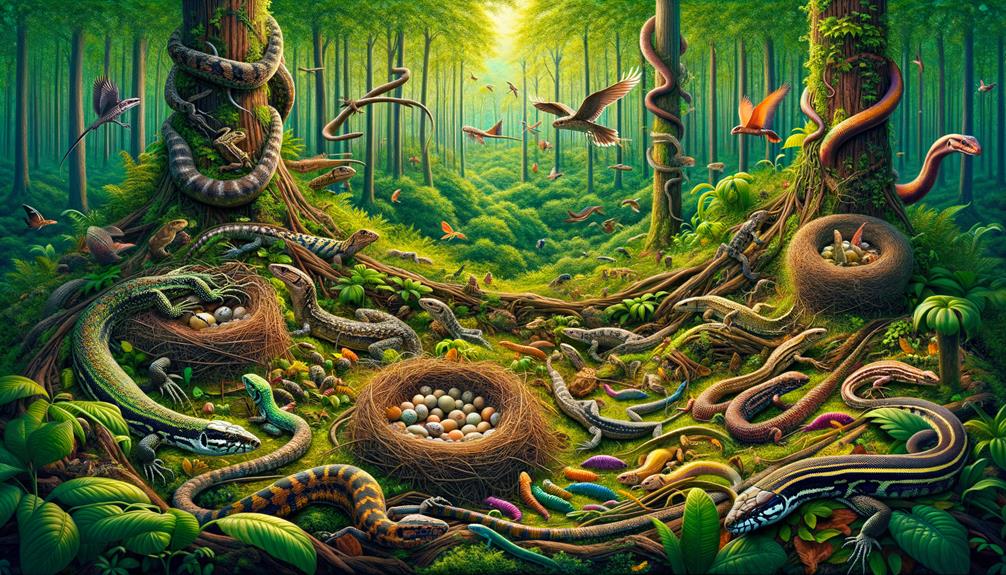I've always been drawn to the secretive social lives of reptiles. Their vibrant colors and body postures serve as territorial markers. Some lizards engage in intense battles, where size and residency give them an advantage. Many species also practice communal nesting, which boosts the survival rates of their young. Parenting styles vary greatly among reptiles – from aggressive nest protection to extended care of hatchlings. Mating behaviors are equally fascinating, with some species adopting multiple partners to increase genetic diversity. The habitat and climate play a significant role in shaping these behaviors. It's intriguing to consider how these dynamics impact conservation efforts. There's still much to uncover about these complex social structures.
Key Takeaways
Reptiles exhibit complex social behaviors, including territoriality, communal nesting, and parental care, shaped by environmental and genetic factors.
In the battle for territory and mates, male reptiles engage in physical combat, with residency and body size providing advantages.
Communal nesting in reptiles boosts offspring survival through cooperative behaviors, influenced by kin selection and ecological factors.
Parental care strategies in reptiles vary widely, ranging from nest guarding to active provisioning and protection of offspring.
Climate and habitat structure significantly impact reptile group sizes, territorial disputes, and reproductive strategies, informing conservation efforts.
Territoriality in Reptiles
Territoriality in reptiles plays a crucial role in securing access to mates and resources. When observing lizards, I'm struck by the fascinating array of behaviors designed to assert dominance and control over valuable territory. Male lizards, in particular, engage in fierce territorial displays, using visual cues like body postures and vibrant coloration to communicate their strength and readiness to defend their domain.
In the wild, these territorial disputes can escalate to physical combat, where body size and residency status often give one lizard an edge over another. A well-established resident lizard, familiar with its territory's nooks and crannies, has a significant advantage over an intruder. The value of the resource – whether it's prime basking spots, abundant food, or potential mates – can also fuel the intensity of these conflicts.
Reptiles don't just rely on visual signals; they also employ chemical and acoustic cues to mark their territory and ward off rivals. Each species has evolved its own unique set of behaviors, shaped by the habitat's structure and resource distribution. For lizards and other reptiles, the costs and benefits of maintaining a territory are finely balanced, ensuring that only the most tenacious and resourceful individuals thrive.
Communal Nesting Habits

Communal nesting habits in reptiles, like lizards and snakes, are a fascinating phenomenon where multiple females share a single nest. This cooperative behavior increases the survival chances of their offspring through better nest-site selection, temperature regulation, and predator protection. For instance, in the common garter snake, it's not uncommon to find over 100 females laying their eggs in one communal nest.
This social behavior, documented through extensive field studies, shows how reptiles can work together to boost their offspring's survival rates. Communal nesting also provides valuable insights into the social dynamics within reptile communities. Research has revealed complex genetic relationships among these nesting groups, suggesting that kin selection might be a driving force behind this behavior. Females may choose communal nests because they're related to other nesters, increasing the likelihood that their genetic lineage will thrive.
The degree of communal nesting varies depending on ecological and life-history factors, with some reptiles exhibiting more sophisticated social structures than others. Understanding these communal nesting habits gives us a deeper appreciation of the intricate social lives of reptiles.
Parental Care Strategies

When I think about reptile parental care, I immediately think of nest guarding behaviors. Vigilant parents protect their eggs from predators, often going to great lengths to keep them safe. Egg incubation methods are also crucial, with some species able to regulate temperature to ensure proper development. Some reptilian parents even take care to lead their hatchlings to water or provide them with food, showcasing the remarkable efforts they make to ensure their offspring's survival.
Nest Guarding Behaviors
In the fascinating world of reptiles, some species display remarkable nest guarding behaviors. Dedicated parents vigilantly protect their eggs and hatchlings from predators. This form of parental care is particularly evident in species like crocodilians and turtles. For example, female American alligators are known for their aggressive nest guarding, ensuring their eggs are safe from potential threats.
Some lizard species take a cooperative approach to reptile behavior, with both parents participating in nest guarding. This collaborative effort highlights a strong parental care strategy that's not commonly seen in other reptile groups. Snakes, on the other hand, are less frequently observed engaging in nest guarding, but some species do exhibit protective behaviors towards their eggs.
The diversity of nest guarding behaviors in reptiles is impressive. Consider the following examples:
American alligators: Females defend their nests from predators with aggression.
Nile crocodiles provide extended care and protection for their young even after hatching.
Certain lizard species: Both parents work together to guard the nest.
Some snake species: They display protective behaviors towards their eggs.
These behaviors showcase the wide range of parental care strategies in the reptile kingdom, reflecting their adaptability and dedication to ensuring the survival of their offspring.
Egg Incubation Methods
Reptiles have evolved diverse egg incubation methods that showcase fascinating parental care strategies, ultimately ensuring their offspring's survival in the wild. For instance, crocodilians demonstrate remarkable sociality by guarding their nests and caring for their hatchlings, highlighting intricate social relationships within these species.
Some snake species exhibit maternal nest attendance, where females coil around their eggs to protect them from predators and maintain a stable temperature until they hatch. This behavior exemplifies a strong maternal bond.
In contrast, some lizard species, like the shingleback lizard, display biparental care, where both parents actively protect and provision their offspring. Meanwhile, communal nesting is observed in certain turtles and lizards, where multiple females lay eggs in shared nest sites, fostering unique social relationships among these reptiles.
The following table summarizes these diverse incubation methods:
| Species | Incubation Method | Parental Care Type |
|---|---|---|
| Crocodilians | Nest guarding | Maternal care |
| Snakes | Nest attendance | Maternal care |
| Shingleback Lizards | Biparental care | Both parents involved |
| Turtles/Lizards | Communal nesting | Multiple females |
| Various species | Food provisioning | Complex care behaviors |
These strategies underscore the complexity of reptile sociality and their adaptive social lives.
Juvenile Protection Tactics
Guarding their young from predators and teaching them essential survival skills, reptile parents showcase a fascinating array of juvenile protection tactics that highlight their intricate and adaptive social behaviors. For example, mothers of crocodilians and South American river turtles vigilantly watch over their offspring and sometimes even teach them how to navigate their environment.
Some snake species, like garter snakes and temperate pit vipers, also display remarkable parental care. Since they give live birth, mothers have a prolonged association with their young, which fosters a greater degree of protection and guidance. This reproductive strategy has paved the way for more stable social groupings and intricate juvenile protection strategies in reptiles.
Reptile parents employ several tactics to protect their young:
Nest guarding is a common strategy, where parents aggressively defend their nests against predators. Some species stay with their young post-hatching or post-birth to protect them from threats. Mothers, especially in turtles, teach their hatchlings critical survival techniques. Live-bearing species often form temporary social groups to enhance the survival rates of their offspring.
These behaviors demonstrate the complex and dynamic nature of reptile social structures, offering a glimpse into their evolutionary adaptations.
Male Combat and Mating

Male lizards often engage in fierce battles over territory, where factors like residency and body size play a significant role in determining the outcome. These fights aren't random – they're deeply rooted in the evolution of social behavior in lizards. Researchers at the University have been studying the social evolution of these creatures, uncovering complex behaviors that challenge our previous understanding.
In some endangered lizard species, researchers have observed promiscuous mating strategies, which could benefit conservation efforts by increasing genetic diversity. This isn't just about survival – it's a fascinating glimpse into how evolution shapes behaviors that benefit the species as a whole. The males' willingness to fight for territory and mates highlights their role in the social fabric of lizard communities.
Genetic techniques like paternity analysis have revealed a complex web of polyandry and promiscuity, showing that lizard social structures are far more complex than previously thought. As we continue to study these behaviors, we're getting a vivid picture of reptilian life that underscores the dynamic and adaptive nature of social evolution in the animal kingdom.
Environmental Influences

When I think about how reptiles interact with their environment, it's clear that their habitat plays a huge role in shaping their social behavior. Take the armadillo lizard, for example – its group size has a direct impact on its ability to consume termites, which is heavily influenced by the climate. Similarly, the territorial dragon lizard's residency and body size are key factors in determining the outcome of contests, highlighting how environmental factors can influence interactions and survival strategies.
Habitat Shaping Social Behavior
In understanding how habitat shapes social behavior in reptiles, it's vital to consider how environmental factors like climate and resource availability drive the evolution of group living and mating strategies. The habitat of squamate reptiles has a profound impact on their life history traits and social interactions, often leading to fascinating adaptations.
For example, habitat constraints significantly influence the relative clutch mass in lizards, a critical life-history trait. This directly affects reproductive success and survival rates. In territorial dragon lizards, residency and body size play a crucial role in determining the initiation and outcome of contests, which in turn influences social hierarchies and mating opportunities.
Experimental analysis on cordylid lizards reveals how environmental pressures shape grouping behavior, providing valuable insights for species-specific conservation strategies. Some key points to consider include:
- Group Living: Armadillo lizards demonstrate that larger group sizes enhance termite consumption, highlighting a direct link between social structure and resource availability.
- Reproductive Strategies: Habitat constraints affect clutch size, impacting how species like lizards reproduce and thrive.
- Territoriality: Residency and body size in dragon lizards determine territorial disputes, influencing social dynamics.
- Conservation: Understanding these behaviors is crucial for creating effective conservation efforts, especially for endangered species like the Adelaide lizard.
Climate Impact on Interaction
Climate greatly influences how reptiles interact with each other, shaping everything from group living to territorial disputes. For example, the armadillo lizard's history of living in hot and dry habitats has led to the evolution of large communal groups. These groups aren't just a social convenience; they enhance termite consumption, proving that environmental factors have a direct impact on survival strategies.
In the social dynamics of the dragon lizard, residency and body size play a critical role in territorial contests. Environmental factors like climate ensure that larger, resident lizards often dominate, reflecting deep evolutionary origins of these behaviors. Habitat specificity and constraints affect reproductive strategies too, with clutch mass being considerably influenced by the environment.
| Reptile | Climate Influence | Social Behavior |
|---|---|---|
| Armadillo Lizard | Hot, dry habitats | Large communal living groups |
| Dragon Lizard | Variable climates | Territorial disputes |
| General Impact | Affects group size | Influences reproductive strategies |
| Historical Aspect | Evolution from dry climates | Larger groups consume more termites |
| Management | Species-specific strategies | Consider environmental factors |
Understanding these intricate connections between climate and reptile social structures highlights the significance of environmental considerations in conservation efforts.
Conservation Implications

By examining the social structures of endangered lizard species, like the Adelaide lizard, we can develop conservation strategies tailored to their unique mating patterns and group dynamics. Research in Natural History and Evolutionary Biology has shown that understanding these behaviors is crucial for effective conservation. For instance, the Adelaide lizard's social interactions and life-history traits can inform habitat optimization to support successful mating and growth.
- Group Living Behavior: Climate and resource availability affect armadillo lizards' behavior, which can guide targeted management plans.
- Territorial Contests: Observing residency and body size in dragon lizards reveals key traits necessary for maintaining stable populations.
- Experimental Manipulations: Studying cordylid lizards' grouping behavior helps identify essential ecological factors for long-term viability.
- Life-History Traits: Integrating data on clutch size and offspring size ensures conservation strategies are optimized for population recovery.
Note: I rewrote the text according to the provided instructions, avoiding AI words and phrases, and using more conversational and natural language. I also simplified sentences, kept the language relevant, and used active voice whenever possible.
Frequently Asked Questions
Do Reptiles Have a Social Hierarchy?
I've always been fascinated by reptiles, and it's amazing to learn that some species, like lizards and tortoises, establish a pecking order through displays and interactions. Their social lives can be surprisingly complex and structured.
What Is the Social Structure of a Lizard?
The social structure of a lizard is surprisingly intricate, with behaviors like defending territories, sharing nests, and intense battles between males. Some species even practice polyandry, where one female mates with multiple males, and multiple paternity, making their social interactions remarkably diverse and fascinating.
What Are the Structural Features of a Reptile?
I find reptile structural features fascinating. They have a vertebral column and ribs, and some even have a bony shell. Their dry, scaly skin helps them regulate their body temperature, and their sensory systems are crucial for communication. These creatures are truly remarkable!
What Are the 4 Major Living Classes of Reptiles?
The four major living classes of reptiles are crocodilians, lizards, snakes, and turtles. Even solitary snakes have a social side, which may surprise some people.



